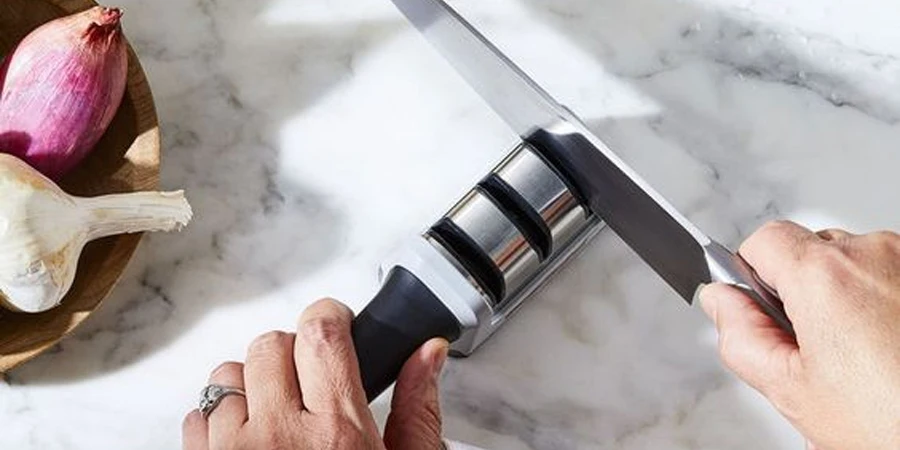Knife sharpeners are essential tools that ensure culinary blades perform at their best, contributing to both safety and efficiency in kitchen operations. A well-maintained sharp edge on knives reduces the effort required in cutting tasks, minimizing fatigue and enhancing precision. These devices range from manual stones to advanced electric systems, each designed to cater to specific sharpening needs and blade types. The evolution of knife sharpeners continues to integrate technological improvements, making them an indispensable asset in both domestic and professional environments, where the demand for precision and reliability remains high. This guide examines the key considerations in selecting knife sharpeners, helping ensure that every slice meets the mark.
Table of Contents
1. Knife sharpener varieties and their applications
2. Market insights for knife sharpeners
3. Criteria for selecting knife sharpeners
4. Leading knife sharpener models and features
1. Knife sharpener varieties and their applications
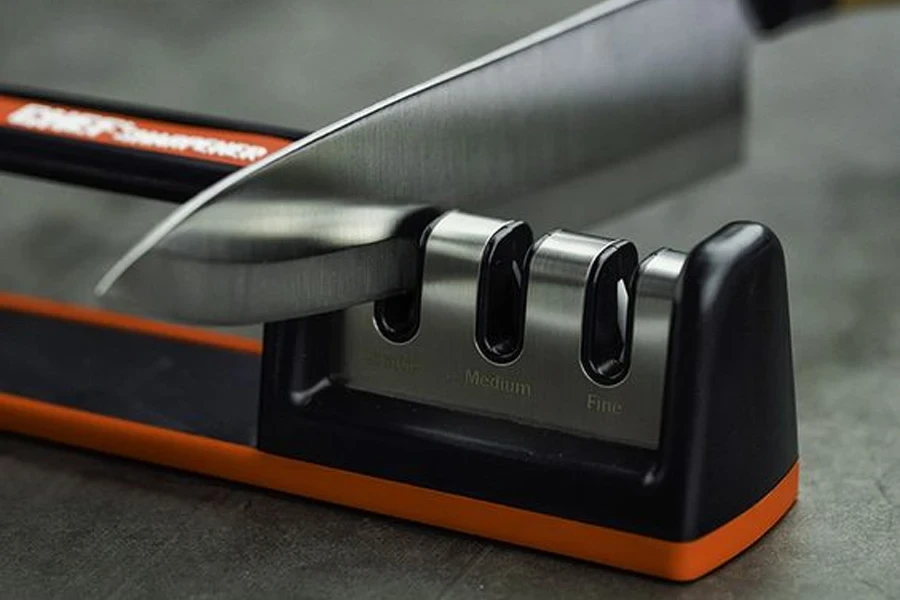
The selection of knife sharpeners in 2024 offers a diverse range of models and functionalities to accommodate different sharpening needs across various environments. As technology advances, the efficiency and precision of these tools continue to improve, catering to both home users and professional settings.
Different types of knife sharpeners
1. Electric sharpeners: These devices are prized for their speed and minimal manual effort. They typically feature multiple sharpening stages that include coarse grinding and fine honing. For instance, the Chef’sChoice Trizor XV is lauded for its ability to quickly transform dull blades into finely honed edges using a three-stage process that provides exceptional control and precision.
2. Manual sharpeners: These are often more affordable and portable than their electric counterparts, making them ideal for those on a budget or with limited storage space. The Mueller 4-in-1 Knife Sharpener exemplifies this type, offering effective sharpening with various grit options in a compact design. Despite their simplicity, they require more physical effort and skill to achieve the best results.
3. Specialty sharpeners: Designed for specific needs, these sharpeners include models like the Tormek T-4 Bushcraft, which is perfect for heavy-duty and outdoor tools. These devices often come with unique features tailored to the specific types of blades they are intended to sharpen, such as adjustable angles and specialized grinding wheels.
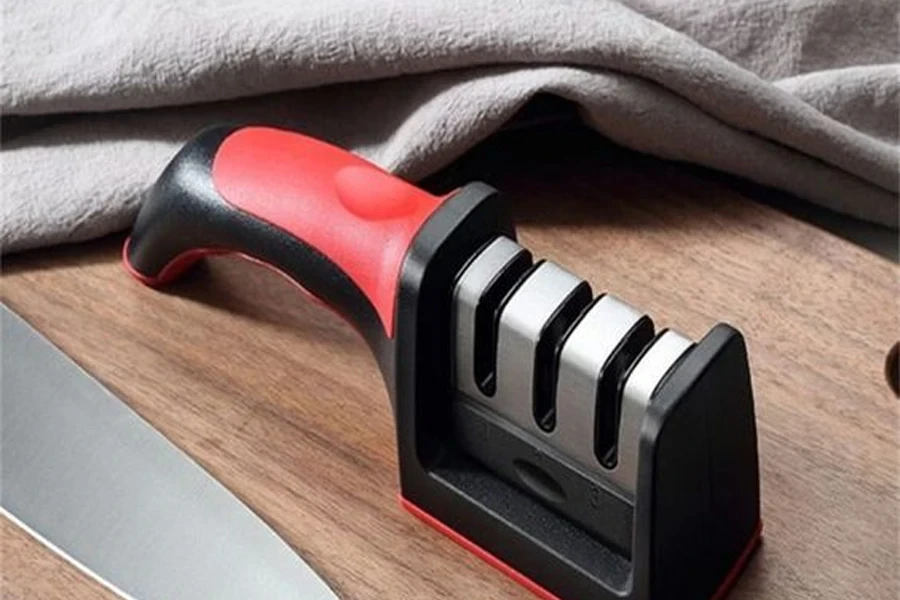
Usage scenarios for various sharpener types
1. Home kitchens: In residential kitchens, where the demand for precision is balanced with the need for convenience, electric sharpeners like the Work Sharp Culinary E5 are often preferred. They provide a quick means to maintain an edge on culinary knives, essential for effective meal preparation.
2. Professional culinary settings: For chefs and culinary professionals, robustness and the ability to finely tune the sharpening process are paramount. Devices like the Wicked Edge Generation 4 Pro offer precision-controlled angles and multiple grit options, enabling chefs to maintain the optimal edge for their high-quality blades.
3. Outdoor and portable uses: For those needing sharpening solutions in the field or on the move, compact manual sharpeners or specialized portable models like the Smith’s Diamond Combination Sharpener prove invaluable. These sharpeners are designed to handle variable conditions and are rugged enough to cope with the demands of outdoor environments.
The variety of knife sharpeners available today ensures that there is a model to suit virtually any situation, from the casual cook at home to the professional chef and the outdoor enthusiast. Whether it is the rapid convenience of an electric model or the precise control offered by a manual stone, the right sharpener can significantly enhance the performance and longevity of any blade.
2. Market insights for knife sharpeners
Current market trends
The market for knife sharpeners is characterized by a growing preference for electric models, which cater to the increased demand for efficiency and convenience in both domestic and professional kitchens. Experts currently value the global knife sharpener market at USD 796.76 million as of 2022, and they expect it to reach USD 1,046.24 million by 2028. They estimate this growth will happen at a 4.64% compound annual growth rate (CAGR) from 2022 to 2028. Electric sharpeners are favored for their ability to deliver consistent results with minimal effort and time. They often feature multiple sharpening stages, from coarse grinding to fine honing, which appeals to users seeking professional-grade sharpness.
Innovation continues to drive the market, with newer models integrating advanced materials like diamond abrasives and precision angle guides. These technological advancements not only enhance the effectiveness of sharpeners but also extend their durability and adaptability to various blade types.
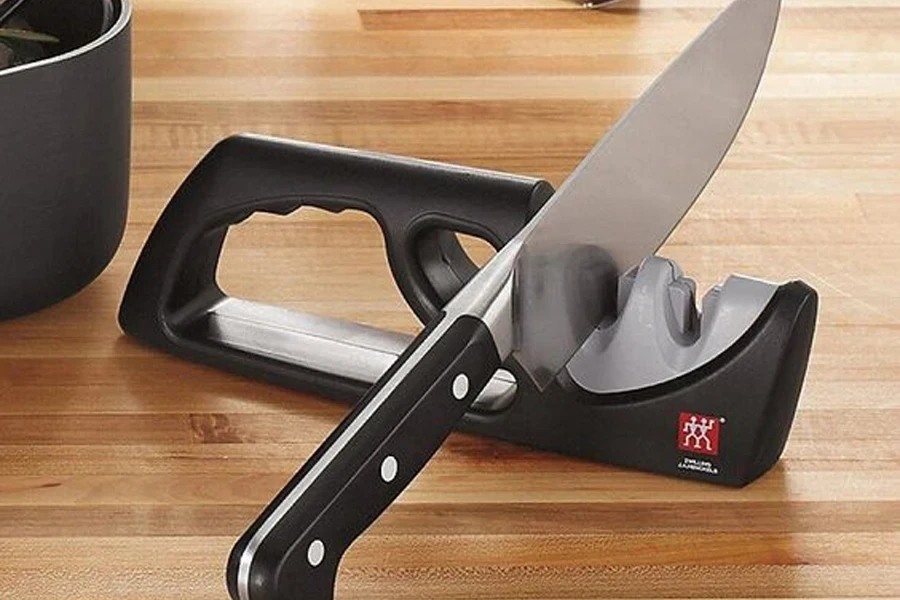
Consumer preferences and demand analysis
Consumer preferences in the knife sharpener market vary significantly based on blade types and usage frequency. For households and settings where knives are used frequently, such as in commercial kitchens, there is a marked preference for robust electric sharpeners that can quickly restore and maintain edge integrity.
On the other hand, enthusiasts and those in less demanding environments often opt for manual sharpeners or specialized systems that offer greater control over the sharpening process. This includes outdoor enthusiasts who favor portable models capable of handling the rigors of outdoor use.
The demand for versatile sharpeners that can accommodate a range of knife styles—from culinary and utility to sporting and craft knives—reflects a broader trend towards multifunctional kitchen tools. Consumers are increasingly looking for products that offer good value for money, evidenced by the popularity of models that combine efficient sharpening capabilities with additional features such as scissors and tool sharpening.
As the market continues to evolve, the intersection of consumer expectations with technological innovations will likely dictate future trends in knife sharpener designs and functionalities.
3. Criteria for selecting knife sharpeners
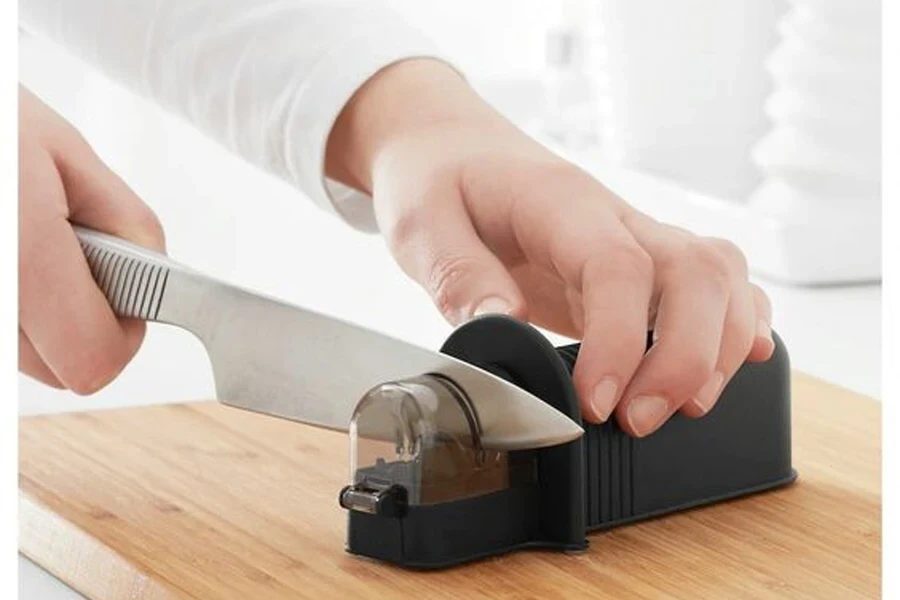
Key features to consider
1. Sharpness efficacy: The primary function of any knife sharpener is to restore and enhance the blade’s edge to optimal sharpness. Electric sharpeners, like the Chef’sChoice models, often deliver superior sharpness efficacy through multi-stage processes that include both grinding and honing. The effectiveness of these devices can be measured in the smoothness and precision of cuts they enable, which is crucial for both culinary professionals and home cooks.
2. Durability and build quality: A sharpener’s longevity and reliability depend significantly on its construction. High-quality materials such as diamond abrasives are known for their ability to withstand repeated use without degrading. The Chef’sChoice 1520, for instance, is noted for its robust design that accommodates frequent use, which is essential for users who rely on their sharpeners regularly.
3. Safety features: Given the inherent risks involved with sharpening knives, the safety features of a sharpener are paramount. Many high-end models incorporate secure grips, non-slip bases, and protective barriers between the blades and the user’s hands. Additionally, features like magnetic debris collectors help in maintaining a clean and safe sharpening environment by preventing metal filings from scattering.
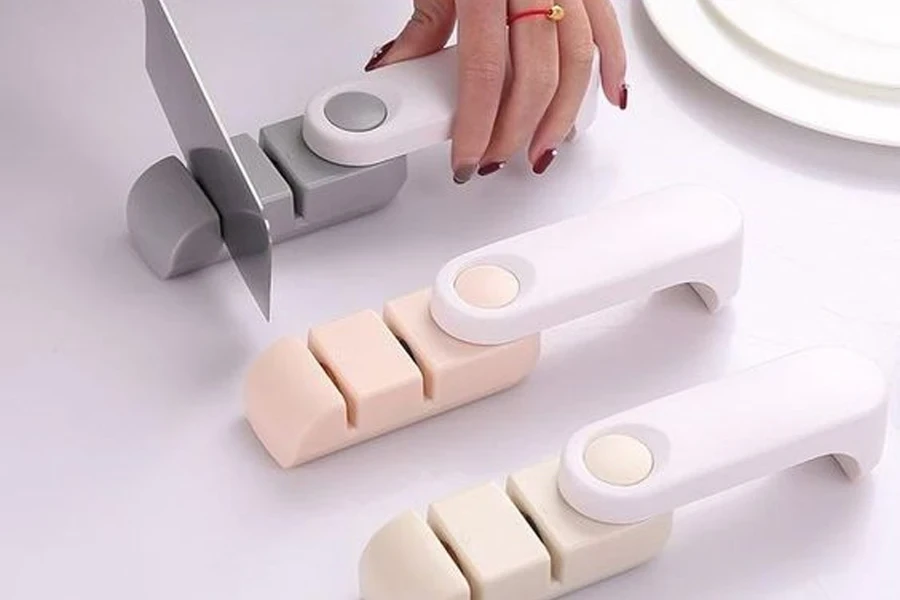
Evaluating sharpener suitability based on knife type
1. Matching sharpener types with knife materials and designs: Not all sharpeners are suitable for every type of knife. For example, ceramic blades require diamond abrasives due to their hardness, which is beyond the capability of lesser materials like tungsten or steel. Electric sharpeners often provide adjustable angles to cater to different blade geometries, which is crucial for maintaining the correct edge on various knives, from Japanese chef’s knives to heavier Western-style butchers’ knives.
2. Adaptability and precision: The ability of a sharpener to adjust to different blade configurations without compromising the quality of the edge is a significant factor in its suitability. For instance, the Work Sharp Ken Onion Edition is renowned for its adaptability, offering precise angle control that can accommodate a wide range of knives, from delicate filleting knives to robust hunting knives.
Selecting the right knife sharpener involves a careful consideration of these features against the specific needs of the user. Whether in a professional setting or at home, the right sharpener not only maintains the quality and longevity of knives but also ensures safety and efficiency in their ongoing use.
4. Leading knife sharpener models and features
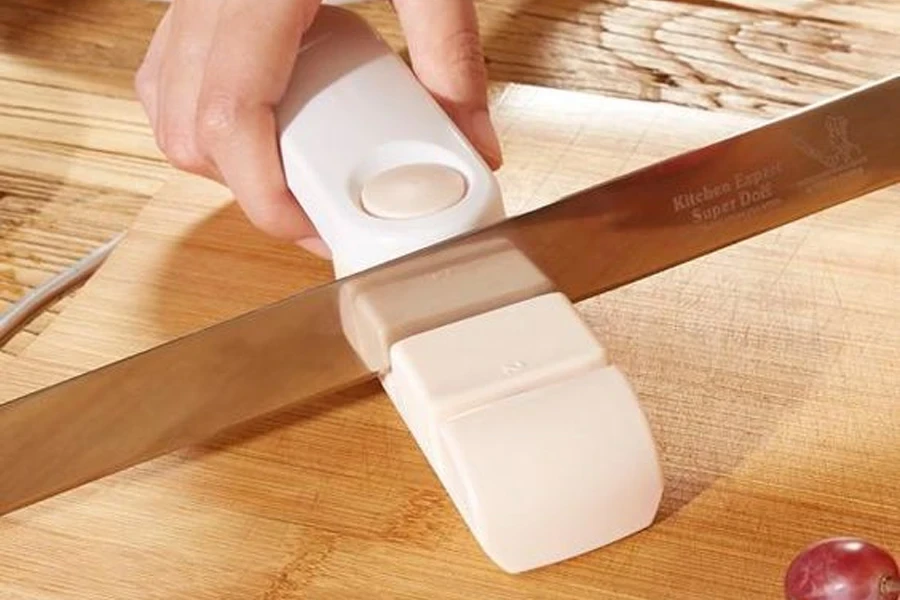
Review of top electric sharpeners
The landscape of electric knife sharpeners is dominated by models that combine power with precision, simplifying the sharpening process while delivering outstanding results. The Chef’sChoice Trizor XV stands out for its ability to transform dull blades into professional-grade tools through a three-stage sharpening process. This model is particularly noted for its ease of use, where even novices can achieve a fine edge thanks to its automated angle control and robust construction. Comparatively, the Work Sharp Culinary E2 Electric Kitchen Knife Sharpener offers a more cost-effective solution without compromising much on quality. It uses flexible abrasive discs that cater to a variety of knives, making it a versatile choice for less frequent needs.
Highlight on manual and specialty sharpeners
Manual sharpeners appeal to those seeking control over their sharpening process or those with more limited budgets. The Mueller 4-in-1 Knife Sharpener is praised for its effectiveness and affordability, providing excellent value for money. It stands out for its ergonomic design and simplicity, suitable for users who prefer a hands-on approach without the need for electricity. On the specialty front, the Idahone Fine Ceramic Sharpening Rod is favored for its gentle yet effective honing capability, perfect for maintaining an edge rather than forming one.
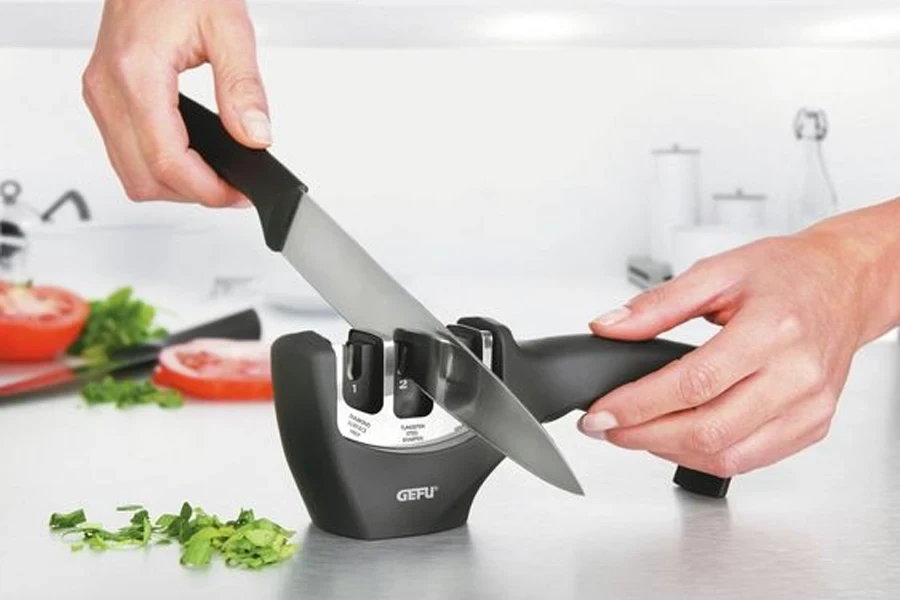
Case studies: Performance analysis of selected models
Real-world applications reveal that high-end electric sharpeners like the Chef’sChoice Trizor XV offer significant time savings and consistency, essential in professional settings where time and precision are critical. This model has been tested extensively, showing its capability to maintain sharpness across a variety of knives, from delicate fillet knives to robust chef’s knives. The Work Sharp E2, while slower, is still effective for residential users, demonstrating its utility in everyday kitchen tasks without the intimidation factor of more complex machines.
Each of these models has been rigorously evaluated for their performance, ease of use, and durability, ensuring that they meet the high standards expected by culinary professionals and enthusiasts alike. Whether for commercial or home use, selecting the right knife sharpener can greatly impact the efficiency and enjoyment of cooking activities.
Conclusion
Selecting the appropriate knife sharpener is crucial for maintaining the precision and effectiveness required in both professional and home kitchens. As demonstrated, the market offers a variety of options, from sophisticated electric models to simple manual tools, each designed to meet specific sharpening needs. Investing in a quality sharpener ensures that culinary tools perform at their best, enhancing both safety and efficiency in food preparation. This strategic approach supports sustained culinary excellence and operational productivity.
